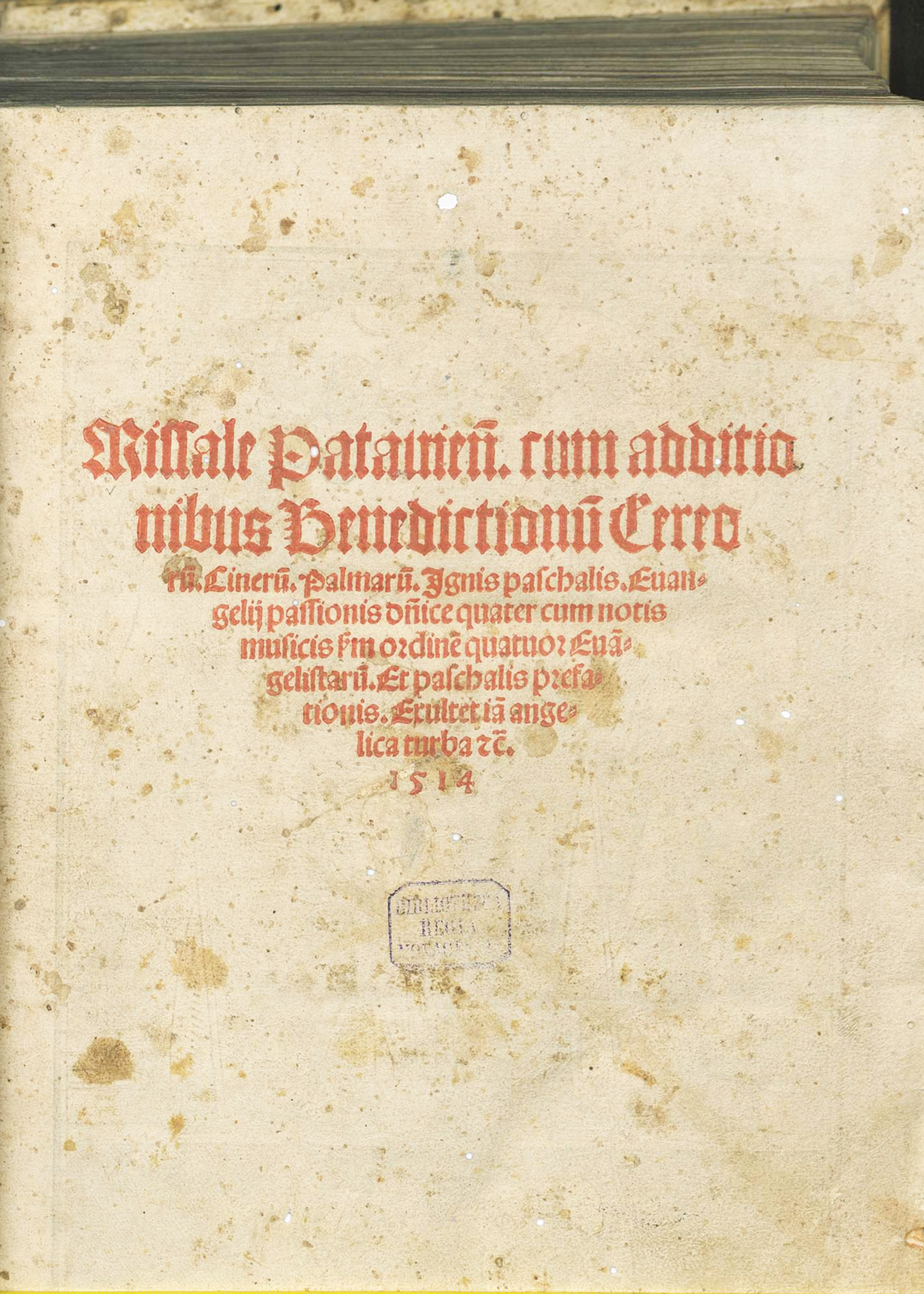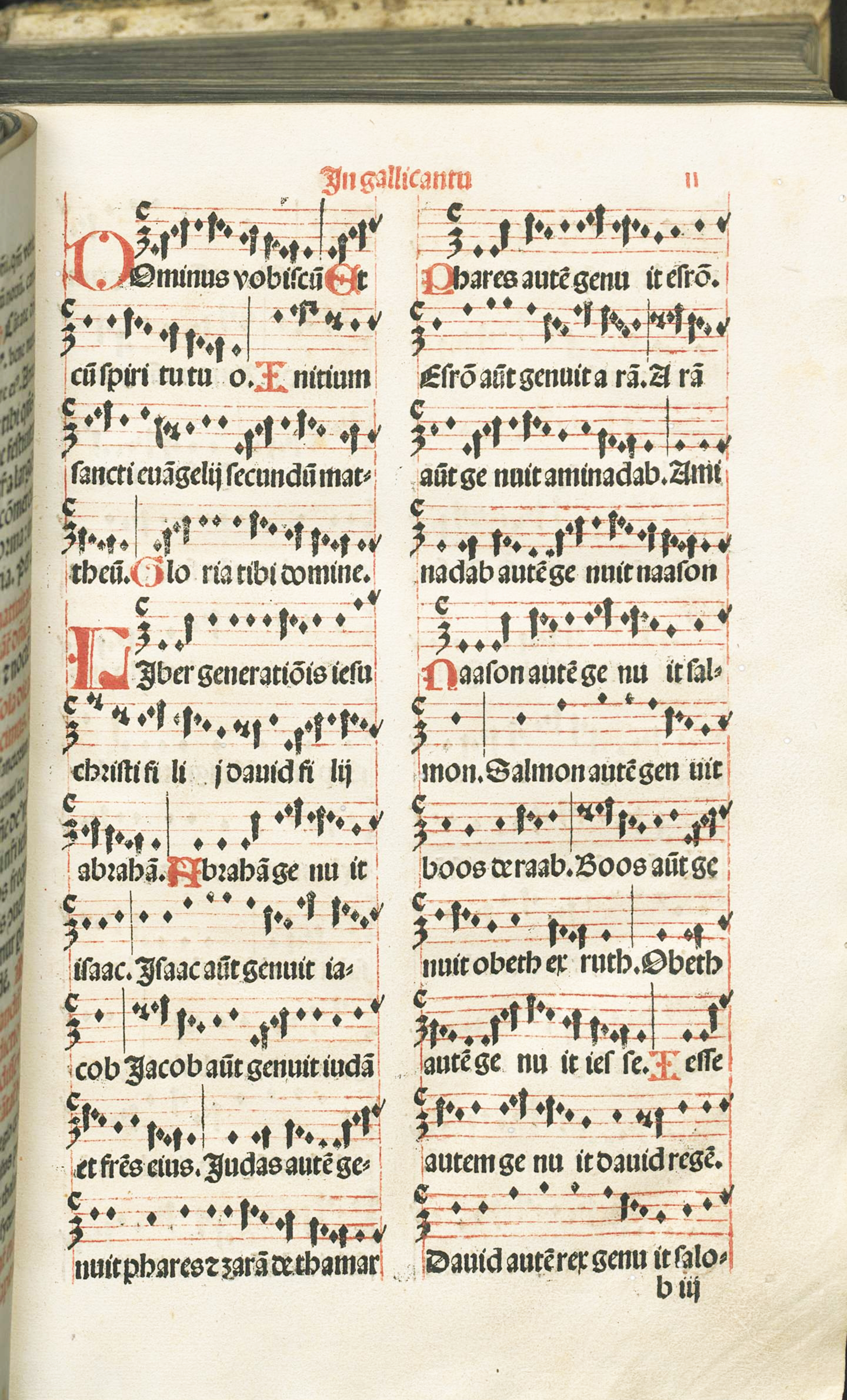Nuremberg: Jobst Gutknecht, 1514, vdm: 287
Missale Patauieñ. cum additio||nibus Benedictionũ Cereo||rũ. Cinerũ. Palmarũ. Ignis paschalis. Euan⸗||gelij passionis dñice quater cum notis || musicis ẜm ordinē quatuor Euã⸗||gelistarũ. Et paschalis prefa⸗||tionis. Exultet iã ange⸗||lica turba &c̃.|| 1514 ||
Hoc p̃sens missale ẜm chorū || Patauieñ. om̃ibus cū requi⸗||stis : alijsq𝔷 multis suꝑaddi⸗||tis: studiosissime reuisū: cor⸗||rectū emendatū. In clarissi⸗||mo oppido Nurnbergeñ.im||pensis prouidoꝝ viroꝝ Ja⸗||cobi Heller:necnon Henrici || Hermañ de wimpffen.ꝑ Io⸗||docū Gutknecht impressorē.|| Anno salutis M.D.xiiij. vij.|| kał. Nouembris: fideliter ela||boratū. finē excepit.||
Nuremberg
Liturgical book
This is the only known Missale edition printed by Gutknecht.
IIr-✠1v: Calendar.
✠2r-✠2v: calculation of Easter.
✠4r-✠5v: Tabula dñicaꝝ [...] (index).
On the verso of the first leaf there is a full page woodcut with St. Stephen and two bishops dated 1514 that shows the initials FH and WT (179 x 251 mm). On ✠2r there is a to calculate the date of Easter (77 x 78 mm). Before canon full-page woodcut of crucifixion (dated 1514). Decorated woodcut initials throughout.
Latin
[12], 1-156, [30], 157-356
D-Mbs Rar. 2285
D-Mbs (2)

multiple impression
Rotunda, Uncial
red staff lines, red type on title page, red initials, red text
The music on i8v-p5v is printed in two columns. Each column measures 76 mm. Between the two columns there is a gap of 9 mm. Starting on v1r the music (for Prefaces and mass parts) is printed across an entire page. Theses pages are framed with double margins to the left and right, in which the clefs and custodes are printed.The Uncial initials are mainly in red. The red staff lines are very thin, and often poorly inked. It is unclear whether they were printed from pieces of type (with four lines each) or nested. Gutknecht uses a great variety of font sizes. Most of the text is printed in two columns. The calendar and the canon however are given in one column.
Hufnagel notation
full-length staff (v1r): 152 mm x 10 mm; height of virga: 7.3 mm
There is a very limited number of notational forms. Most of the notes are given with punctus. Virgae and other ligatures are only used for melismas.
chant
i8v-l2r: Passio Domini secundum Mattheum
l4r-m4r: Passio Domini secundum Marcum
m5r-n5r : Passio domini secundum Lucam
n8r-o6r: Passio domini secundum Johannem
p3r-p5v: Easter proclamation
v1r-y4r: Solemn, 'mediocriter' and ferial prefaces for different liturgical feasts
y5r-y6v: Kyrie, Gloria, Credo, Ite missa
A-KN, A-KR, A-LIs, A-M, A-SEI, A-SFI, *A-Su, D-B, D-BAs, D-Mbs, *D-Mbs, F-Pn, H-Efko, IRL-Dtc, US-Wc
Passau: Johann Petri, [1491–1492 c.], vdm: 1452 Augsburg: Erhard Ratdolt, 1494, vdm: 1081 Augsburg: Erhard Ratdolt, 1498, vdm: 1088 Augsburg: Erhard Ratdolt, 1503, vdm: 229 Vienna: Johann Winterburger, 1503, vdm: 224 Augsburg: Erhard Ratdolt, 1505, vdm: 780 Augsburg: Erhard Ratdolt, 1505, vdm: 236 Vienna: Johann Winterburger, 1507, vdm: 679 Vienna: Johann Winterburger, 1509, vdm: 244 Vienna: Johann Winterburger, 1512, vdm: 281
Molitor, P. Raphael. Deutsche Choral-Wiegendrucke. Ein Beitrag zur Geschichte des Chorals und des Notendrucks in Deutschland. Regensburg etc. 1904. Repr. Hildesheim: Olms, 1982 (68)
Weale, William Henry James. Bibliographia liturgica: Catalogus missalium ritus latini ab anno MCCCLXXV impressorum. Edited by Hanns Bohatta. London: Quaritch, 1928 (777)
Daschner, Dominik. Die gedruckten Meßbücher Süddeutschlands bis zur Übernahme des Missale Romanum Pius V. (1570). Frankfurt am Main: Lang, 1995
Panzer, Georg Wolfgang. Annales typographici ab artis inventae origine ad annum MD, 11 volumes. Nürnberg: Johannes Eberhard Zeh, 1783-1803 (7:455, 108)

Defective; pages missing.
Defective; pages missing.
The copy looks quite pristine.
The woodcuts are not coloured.
Bibliotheca aulica Saliburgensis. Old shelfmark C. 25. BAS.
Most of the leather tabs still extant.
Some manuscript additions to text.
An early user has inserted markers to separated words in the chants.
Fols. 19ff after 157: handwritten annotations to indicate for which feast the different Mass incipits could be used.
Handwritten addition (c. 1600?) of an additional Gloria for masses of the Virgin; additional Ite missa est for the Easter vigil; additional Benedicamus domino “in vigilijs et feriatis diebus”.
Hand-coloured woodcuts.
The canon is printed on vellum.
stamp on binding: WAIA; 1597
D-Mbs (2)